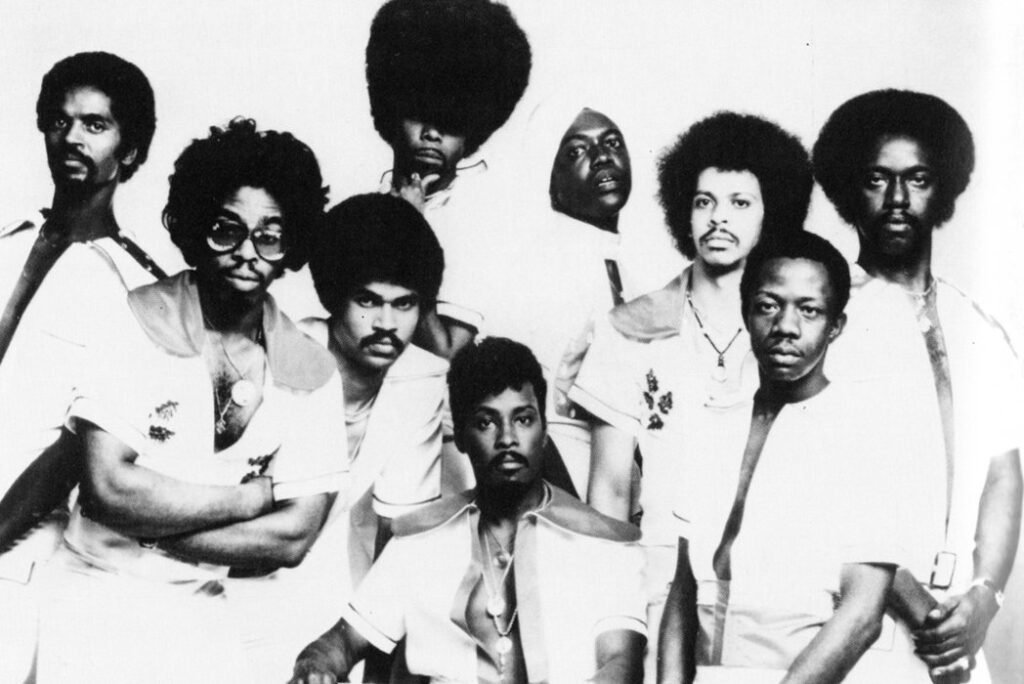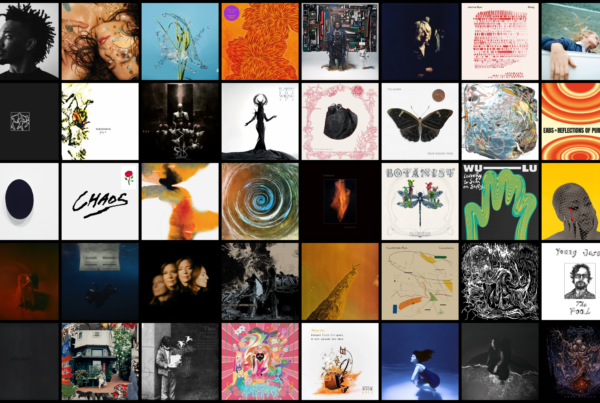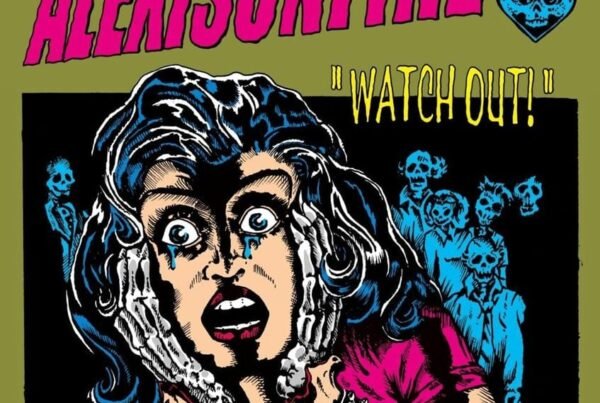And we are back with our next episode! This time around, we are once again visiting the ’70s – 1977, to be precise. Star Wars defined what a blockbuster is, New York had a major blackout, Elvis Presley died. Many things happened (like each year, I guess), and a lot of music got released.
Some of it will be the topic of NOISE UPON A TIME today, and I’m very stoked got get going with y’all!
Jon Hassell – Vernal Equinox
released 1977, by Lovely Music, Ltd.
revisited by Dominik Böhmer

First things first: I find the cover for Jon Hassell’s 1977 début record Vernal Equinox to be a highly satisfying illustration. The thick white border that houses the artist name and record title gives it a sleek, timeless finish, while the centerpiece catches your eye with its balance of pinkish tones, terracotta, and green. Bonus points for actually having the correct time for the vernal equinox (or March/northward/spring equinox) displayed on the calendar; that’s good attention to detail. This is the kind of cover art I find instantly inviting, and hell, it fits the record’s warmth and radiance quite beautifully.
Vernal Equinox is where we got our first recorded glimpse at Hassell’s Fourth World philosophy, which the man himself described as ‘a unified primitive/futuristic sound combining features of world ethnic styles with advanced electronic techniques.’ In less oblique terms, you could call it a fusion of jazz, early (ambient) electronica, and various styles of traditional music from around the world. Leaving aside the more… unsavory bits of his views regarding this fundamental concept he established, it’s fair to say that Hassell’s music is still highly influential to this day, as shades of it can be found across the board – from similar jazz explorers like Arve Henriksen of Joseph Shabason to countless other musicians within the fields of ambient and art music.
His lasting legacy despite relative (mainstream) obscurity speaks volumes of the magnetic pull Hassell’s music develops on the listener once you actually do stumble across it. Vernal Equinox is there the cornerstone of that legacy was laid. Together with an ensemble that included, among others, legendary Brazilian percussionist Naná Vasconcelos, Hassell ventured out into uncharted territory with nothing but his musical reference points to guide him towards the holistic, all-encompassing sound he sought to achieve. While this album didn’t see him perfect it just yet, it does give us a candid and thoroughly enjoyable look at the road he took to eventually get there.
The first thing you will undoubtedly recognize after “Toucan Ocean” opens with soft percussion is that unmistakable, electronically altered trumpet tone. It sounds delightfully quirky, almost wobbly on this opening track. There’s a warmth to it all, and as the ocean sounds usher you forth, you begin to understand what makes Hassell’s music so appealing. “Viva Shona” brings in field recordings, mbira, and bells into the mix, and it’s just as unhurried as its predecessor. This isn’t your standard aloof ambient music – this is an ambience that’s rooted firmly in the warm soil of our dear mother Earth. Then, “Hex” carries its momentum through what sounds like a jazz fusion bass (but might as well be a synthesizer) and various percussion instruments. It sounds a bit more ominous than the previous two, like the night that follows a particularly bright day.
Side A closes with “Blues Nile”, and what a lurching, dirge-like closer it is. Hassell’s horn sounds like it’s merely an echo of the mighty instrument it was mere moments ago, and its melodies creep forward as a background drone dimly illuminates the surroundings like a single torch in pitch-black darkness. This is a blues, alright. Well, don’t stay blue for too long – we’ve still got a whole side of this record ahead of us, waiting to be explored! Title track “Vernal Equinox” makes up the lion’s share of this musical jungle, its 22 minutes of runtime easily eclipsing even its ten-minute forerunner. If “Hex” and “Blues Nile” were the creeping chokehold of night, then this is the glorious return of the sun’s radiance at dusk, the orange disk slowly rising behind black-grey mountains to restore the world’s splendor. Don’t ask, just listen.
As “Caracas Night September 11, 1975“ carries us out of the world of Vernal Equinox and back into our own, its short recap of the journey we undertook reminds us of the beauty we face day in, day out, within the realms of music and on the planet we call our home. For many musicians, a record like this would be a crown jewel of their discography, carefully handled and cherished; for Jon Hassell, this was just the beginning, which should give you a good idea of his overall trajectory, and why he is regarded as a legend in many circles. Radiant beauty and staunch experimentalism don’t have to be mutually exclusive, and this man’s œuvre proves it.
Parliament – Funkentelechy vs. the Placebo Syndrome
released November 28, 1977, by Casablanca
revisited by Dom South

If you asked George Clinton ‘where’d you get that funk from?’, the answer could range from his mother to those who control the mothership to James Brown. Wherever it came from, Clinton and Parliament delivered funk to the moon and back. Funkentelechy vs the Placebo Syndrome is often considered the peak of P-Funk along with their other classics Mothership Connection and One Nation Under a Groove, and with good reason. The entire album is held together with a space-age narrative of Star Child defeating Sir Nose D’Voidoffunk by instilling him with the funk. Even the least funky would struggle to be D’Voidoffunk by the end of the album.
Funkentelechy Vs The Placebo Syndrome ends with the quintessential P-Funk song “Flashlight”. An outlier in their discography with the legendary Bootsy Collins delivering strong but simple drums as the driving bassline comes from Bernie Worrell’s synths. “Flashlight” pulses for around 6 minutes as Worrell’s synth dances in your head. With memorable chanting vocals featuring lines such as ‘everybody’s got a little light under the sun’. As the song progresses, we get more and more elements coming in, more vocals, more synth, horns, and a relentless groove that keeps the dancefloor on fire throughout. Their most successful song and a live staple until Clinton’s recent retirement, the song matches the deepest of grooves with the funkiest of melodies to deliver the highlight of their career.
This isn’t to say that the 5 songs that precede this aren’t full of magic. As they describe themselves, this is heavyweight funk and the rhythm sections plays simple, restrained but pulsing grooves throughout. Musically, this is far from the fastest or wildest P-Funk album there is, but what it lacks in chaos it more than makes up for in pure funkiness. With a huge cast of legendary musicians, including Clinton, Worrell, Collins, Garry Shider, Fred Wesley, Jerome Brailey and vocals from The Brides of Dr Funkenstein, we are treated to quality in every second.

1977 was the year punk broke as disco penetrated the mainstream. The album was a comment on disco and the difficult time of the late ’70s where the world was seemingly more and more devoid of funk. Forever fighting this, Clinton and Parliament doubled down and the depth of their grooves and level of their narrative. With a trademark voiceover, we are driven through a story with the depth of any Hollywood film of the time. One could get lost in the narrative, fighting against the ‘nosiest computer I know’, putting all of their funky power behind Star Child as he uses the ‘greatest invention of all time’, the Bop Gun, to fight against the myriad of forces Sir Nose employs against him. One could also get lost in the grooves, blown away by the quality of the instrumentation, layering, production and the forward thinking nature of this funk classic.
Parliament’s sense of humour and playfulness is fully on show here, Clinton employs lyrics full of puns, childlike wordplay and a generally admirable level of goofing around for a man who can orchestrate an album like this one. The vinyl version of this album comes with a mini-comic (brilliantly written and illustrated by artist Overton Lloyd) of the narrative as well, giving more insight into the inspirations, ideologies and sense of humour that influenced the group. The afro-futurist influence is clear to see, as they continue with pyramid imagery and the alien conspiracy of Ancient Egypt. There is plenty of sci-fi imagery showing African-American characters, something that goes against Hollywood’s sci-fi. Clinton once stated that they had to put black people ‘in places where they had never been perceived to be’, including outer space. This is just a small example of the underlying politics of P-Funk, while playfully creating afro-futurist music, he supported the black freedom movement and while making jokes about being a wizard of finance he takes on the strangeness of an increasingly neo-liberal economy creeping in during the late ’70s.
Parliament-Funkadelic had an incredible run of albums during the ’70s, releasing a plethora of genre-defining albums including this one. The music speaks for itself, but the magic of P-Funk lies deeper. The stage shows were huge, the narratives were massive, and the funk was even bigger. Funkentelechy vs The Placebo Syndrome still sounds fresh in 2022, and inspires me to move like little else before or since.
‘Would you trade your funk for what’s behind the third door?’ Not if you dived into the funky masterpiece that defines this cult of musicians, the genre of funk and the year 1977.
David Bowie – Low
released January 14, 1977, by RCA
revisited by Jake Walters

Famously recorded after David Bowie’s move to Berlin after he and fellow musician Iggy Pop had moved to Europe to sober up and clean up their lives, Low is an interesting moment in the career of one of Earth’s most storied musicians. Opening with a series of what feel like passing thought tracks “Speed of Life” and “Breaking Glass”, these tone setters introduced the world to a new sound for Bowie, blending his rock and roll roots with some danceable electronic moments injected therein. The feeling that these songs give in those opening minutes is that you’ve sort of stumbled into something that was ongoing rather than being there from the start like you’ve walked into a bar where the band is already playing and you feel the need to grab a beer and slide into the vibe.
By the time Low gets to “Sound and Vision”, the mood is a bit more familiar, but the rich electronic layers paired with the brutish drum production give these funky rock beats a brand new feeling. After taking almost half of the song’s runtime to get to actual lyrics, the wait is oh so worth it. That frankly seems the be the modus operandi of this album: patience pays off. The opening salvo shows a lot of restraint and seems to deliberately wait to fully baptize itself in the emotional and sonic weight that it eventually finds. At the time of its release this album divided the critics but it seems that many of them later changed their minds decades later declaring this some of Bowie’s best and most interesting work. Patience really is a virtue.
What I’ve always liked about this record is while there were a lot of things going on in Bowie’s life at this time including self reflection, grasping for sobriety, along with his near-constant evolution, it still feels indelibly drawn from his imagination. This album is a bit of a turning point for Bowie in life, and in his artistic journey as well. While there is genuine wonder and amazement within the songs present on Low, there is also longing for human connection on songs like “Be My Wife”, where he is pouring out his heart lyrically. He’d been all over the world, seen so many things, but the weight of loneliness still haunted him. The ability to interject these emotional tones in an album that doesn’t lean to heavily on prose is quite the feat.
Of course, longing isn’t the only mood that is expressed on this album. From the celebratory “A New Career In Town” to side B’s opener “Warszawa”, the range of feelings and emotions are just as diverse as Bowie’s career. The latter is pure expression through sound and is a new moment for Bowie by flirting with ambient electronics and while a seven-minute song isn’t necessarily a huge risk or surprise in this genre in the current genre norms, a rock star such as Bowie tackling this idea on a major label release is nothing if not ballsy. It’s a genuinely gorgeous track that feels massively influenced by his surroundings at the time but is also a moment of pure expression.
The electronic and ambient experiments continues throughout the rest of Low, and while I’m sure at the time this was a daring and surprising move, so much so that RCA hesitated to release the album in time since it surely seems that once again that Bowie was light years ahead of everyone else. This is the kind boldness that made Bowie the star that he was. His fearlessness to take on new ideas and graft himself into them was a skill that seemed to be almost uniquely his, both then and even now. This album is a reflection of where Bowie was at the time in life, in art, and even geographically. Low may not have the distinction of being a fan-favorite Bowie album, but I will argue that it’s his most emotive.
Ohio Players – Angel
released February 4, 1977, by Mercury
revisited by Daniel Reiser

Ohio is for the Players. Not whatever these dorks are whining about. All it takes is one needle drop on Ohio Players‘ Angel and magic unfolds. It’s absolutely fucking wild these masters brought da phonk on Skin Tight, Fire, and Honey, and just said ‘we ain’t done‘ and dropped a 7-minute opener that gets any hips swaying, and drips sensuality like fucking volcano.
The album art also shows everything you need to know about what you’re about to hear. Angel, just like every other Ohio Players album art, is a photo of a beautiful woman in a sensual pose. Usually they were playboy models, but definitely always invoke the sense of sensuality this 8-piece aims for. It’s fucking cool, and these players pull it off with ease.
The only act that could ever rival the Ohio Players would only be Parliament-Funkadelic. Together, these two acts influenced an entire generation, then another generation, and so on. There’s something special about this album, in that it’s best track is the very first one. The 7-minute eponymous track wastes no time setting the scene with its sensual funk easy r’n’b vibe. The vocals feel like butter as they kick in, and ride the instrumentals for a mellow time.

“O-H-I-O” is also worth mentioning. Its wild cyber static vocals that sound like your TV is trying to communicate with you bounce all over the place until a cult-like chant chimes in with ‘o,h,i,o‘. It has some cowbell (I think?), and some sinister laughing. I’m not really sure there’s another state with a song this cool. And we’re talking about Ohio… it’s wild.
Naturally, one would believe some acts lose steam 3-5 albums in, when innovation isn’t at the forefront. For this album being as good as it is, it’s even wilder this was one of only two releases that year, with the Ohio Players releasing Mr. Mean later in the year, and also this being their ninth studio album. I’m not sure there’s many acts out there that can still provide cohesion, innovation, and genre expansion that far into their career.
1977 fucking jammed, and this album probably sounded so fucking cool blasting through speakers in Camaros and Cadillacs alike. Probably got a lot of parties started, and set the scene for a lot of good dates. Dodging all of that yacht rock and space rock that dominated that decade bears funky ass fruit with gems like this one. The Ohio Players will always be one of those acts that don’t miss the mark. Angel is just even more proof of that.






